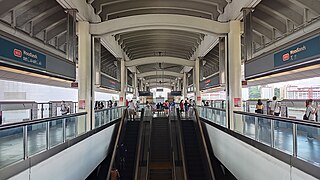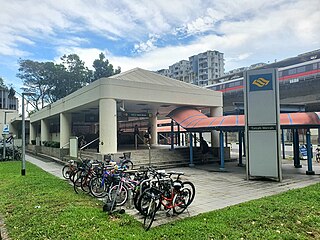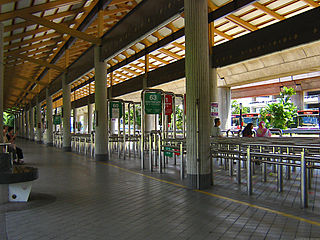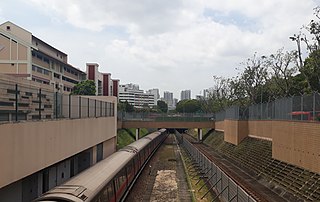
The Mass Rapid Transit system, locally known by the initialism MRT, is a rapid transit system in Singapore and the island country's principal mode of railway transportation. The system commenced operations in November 1987 after two decades of planning with an initial 6 km (3.7 mi) stretch consisting of five stations. The network has since grown to span the length and breadth of the country's main island – with the exception of the forested core and the rural northwestern region – in accordance with Singapore's aim of developing a comprehensive rail network as the backbone of the country's public transportation system, averaging a daily ridership of 3.4 million in 2019.

The North–South Line (NSL) is a high-capacity Mass Rapid Transit (MRT) line in Singapore, operated by SMRT Corporation. Coloured red on the Singapore rail map, the line is 45 kilometres (28 mi) long and serves 27 stations, 11 of which, between the Bishan and Marina South Pier stations, are underground. It runs from Jurong East station, located in Western Singapore, to Marina South Pier station in the Central Area, via Woodlands station in northern Singapore. The line operates for almost 20 hours a day, with headways of up to 1 to 2 minutes during peak hours and 5 to 8 minutes during off-peak hours. All the trains on the North–South Line run with a six-car formation.

The East–West Line (EWL) is a high-capacity Mass Rapid Transit (MRT) line operated by SMRT in Singapore, running from Pasir Ris station in the east to Tuas Link station in the west, with an additional branch between Changi Airport and Tanah Merah stations. It is the second Mass Rapid Transit line to be built in Singapore. Coloured green on the rail map, the line serves 35 stations, 8 of which are underground. At 57.2 kilometres (35.5 mi), the line is the longest on the MRT network.

Bishan MRT station is a Mass Rapid Transit (MRT) interchange station on the North–South (NSL) and Circle (CCL) lines in Bishan, Singapore. The station is located along Bishan Road within the town centre; it is integrated with Junction 8 shopping centre and is close to Bishan Bus Interchange. Nearby schools include Raffles Institution, Catholic High School, and Kuo Chuan Presbyterian Primary and Secondary Schools.

Pasir Ris MRT station is an elevated Mass Rapid Transit (MRT) station on the East West line (EWL) in Pasir Ris, Singapore. Situated along Pasir Ris Central adjacent to Pasir Ris Bus Interchange and the White Sands Shopping Mall, it is the eastern terminus of the EWL and, as of June 2021, the only MRT station within Pasir Ris. The station exterior has the characteristic dome-shaped segmented roof also seen on other elevated EWL stations.

Simei MRT station is an above-ground Mass Rapid Transit (MRT) station on the East–West line in Tampines planning area, Singapore, at the centre of Simei housing estate flanked by Simei Street 1 and Simei Street 3 next to Eastpoint Mall. This station primarily serves Simei, a residential estate part of the larger Tampines New Town.

Tampines MRT station is a Mass Rapid Transit (MRT) interchange station on the East West (EWL) and Downtown (DTL) lines in Tampines, Singapore. Located in the heart of the Tampines town centre next to Tampines Avenue 4, Tampines Central 4 and Tampines Central 5, it is in close proximity to the Tampines and Tampines Concourse bus interchanges. The station also serves the surrounding retail developments of Tampines Mall, Tampines One and Century Square.

Tanah Merah MRT station is an elevated Mass Rapid Transit (MRT) station on the East West line (EWL). Located in Bedok, Singapore, the station is along New Upper Changi Road and serves various residential developments, including Casa Merah. It is the terminus of the EWL branch to Changi Airport station.

Yishun MRT station is an above-ground Mass Rapid Transit (MRT) station on the North South line (NSL) in Yishun, Singapore. The station is located at the junction of Yishun Avenue 2 and Yishun Avenue 5, and is currently one of the two MRT stations that serve Yishun New Town; the other being Khatib station.

Khaw Boon Wan is a Malaysian-born Singaporean former politician who served as Minister for Transport between 2015 and 2020, Minister for National Development between 2011 and 2015, and Minister for Health between 2003 and 2011. A member of the governing People's Action Party (PAP), he was the Member of Parliament (MP) representing the Moulmein division of Tanjong Pagar GRC between 2001 and 2006, and the Sembawang division of Sembawang GRC between 2006 and 2020.

Aljunied MRT station is an above-ground Mass Rapid Transit (MRT) station on the East West line (EWL) in Geylang, Singapore. Named after Aljunied Road, this station primarily serves Aljunied, one of the subzones that make up Geylang planning area. On the EWL, it is between the Paya Lebar and Kallang stations.

Joo Koon MRT station is an above-ground Mass Rapid Transit (MRT) station along the East West Line in Pioneer planning area, Singapore.

The Kawasaki Heavy Industries C151 is the first generation electric multiple unit (EMU) rolling stock in operation on the North–South and East–West lines of Singapore's Mass Rapid Transit (MRT) system, manufactured by a consortium led by Kawasaki Heavy Industries (KHI) under Contract 151. They were first introduced in 1987 and are the oldest trains in operation on the network.

Bishan Depot or is a depot located on the Mass Rapid Transit in Bishan, Singapore. It was completed in 1986 by American architect Vikas M. Gore and the 12,000 square metres maintenance area at cost of S$300 million.

The safety of the Mass Rapid Transit (MRT) system in Singapore was questioned by the public after several accidents on the system during the 1980s and 1990s. Most problems have been addressed, and many safety measures are visible to users of the system.

SMRT Trains Limited is a rail operator in Singapore and a wholly owned subsidiary of SMRT Corporation. After the privatisation of the MRT operations in 1995, it was originally named Singapore MRT Limited. On 31 December 2001, it was renamed to SMRT Trains Limited, so as not to confuse with another MRT line - North East MRT Line that is under Singapore Bus Services and the bus operations merged from Trans-Island Bus Services. At the same time, Singapore Bus Services was renamed to SBS Transit to be multi-modal. SMRT Trains currently manages most of the MRT services in Singapore except the North East Line and Downtown Line.

Eunos Bus Interchange is a bus interchange located in Geylang East, Singapore. It is located and built beside Eunos MRT station and is surrounded by Eunos Road 2, Eunos Crescent and Sims Avenue.

Canberra MRT station is an elevated Mass Rapid Transit (MRT) station on the North South line, located along Canberra Link at the junction with Canberra Way in Sembawang, Singapore. It is the second infill station on the MRT network, and the first in Singapore with a platform linked directly to an overhead bridge at the same level. With several green features included in the station during construction, it was also the first MRT station to be awarded Platinum for the Building and Construction Authority's Green Mark for Transit Stations, as a result of the construction team's efforts to integrate landscaping and using eco-friendly materials in the construction of the station.

The Joo Koon rail accident, sometimes referred to as the Joo Koon train collision, was a crash which happened on 15 November 2017, when a C151A train travelling at 16 kilometres per hour (9.9 mph) rear-ended a stationary C151A train at Joo Koon station on the East West MRT line, resulting in 38 injuries. The stationary train was in the process of being detrained due to a train fault. Both trains were operating under the recently installed Thales SelTrac CBTC signalling system at the time of incident, and the Minister of Transport Khaw Boon Wan expressed that he was "disturbed" by an initial finding that "critical safety software" was inadvertently removed from the stationary train, possibly due to a malfunctioning signalling circuit, which led to the crash. This incident is the second train collision in Singapore MRT's history, after the Clementi rail accident.

The Bishan MRT tunnel flooding was a major incident on the North South MRT line (NSL) of the Singapore MRT which occurred at 5.33 pm on 7 October 2017. The flooding of the tunnels between the Bishan and Braddell MRT stations was caused by heavy rain and a faulty maintenance pump. The flooding completely blocked the tunnel, and bus services had to be deployed while the Singapore Civil Defence Force and maintenance staff removed the water from the tunnel. The incident caused more than S$2 million in damages and lost revenue for the operator SMRT and led to the firing of eight maintenance employees.





















